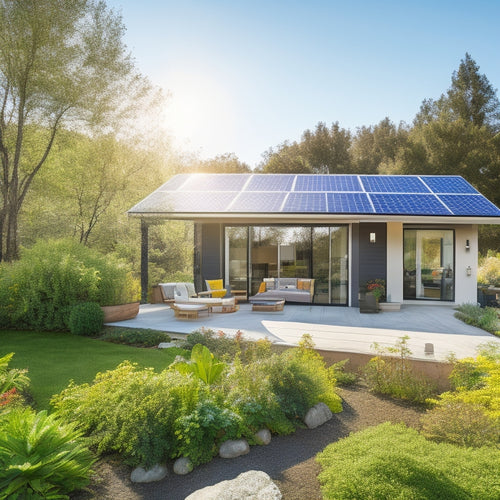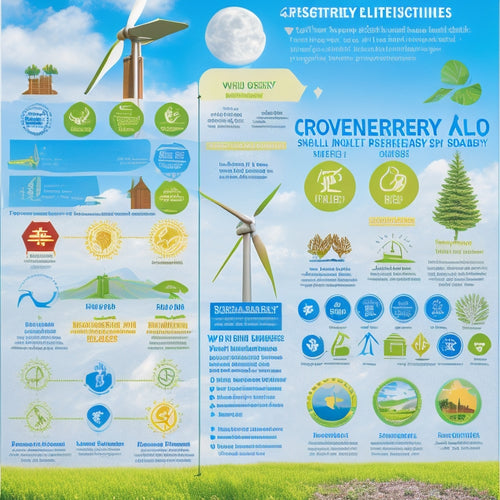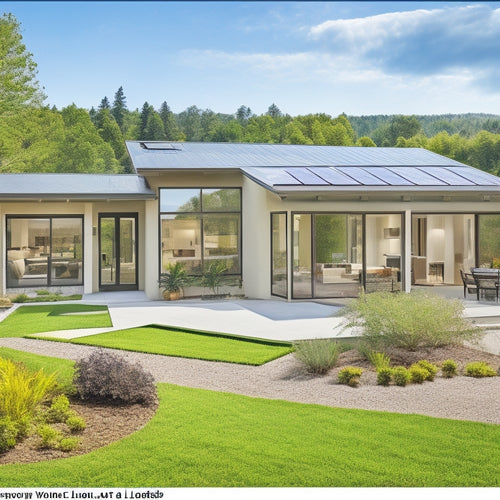
What Does Solar Panel Maintenance Really Cost?
Share
Maintaining your solar panels involves various costs. Regular cleaning might cost $150 to $300, ensuring peak sunlight capture. Inverter replacements, necessary every 10 to 15 years, range from $500 to $2,000. Repairs for micro-cracks or hot spots can cost anywhere from $100 to $500. Monitoring systems, important for efficiency, start at $300 for setup, with annual fees around $100 to $300. Annual inspections run between $100 to $300, while extending warranties and addressing miscellaneous issues like bird deterrents add to expenses. Balancing DIY efforts with professional services can further affect costs. There's more to uncover about planning and optimizing these expenses.
Key Takeaways
- Regular cleaning costs range from $150 to $300, essential for optimal sunlight capture.
- Inverter replacement ranges from $500 to $2,000, necessary every 10-15 years.
- Annual inspection fees are $100 to $300, crucial for system efficiency.
- Monitoring system setup costs $300 to $1,000, with annual fees between $100 and $300.
- Repair costs for common issues vary from $100 to $500, depending on the problem.
Regular Cleaning Fees
https://www.youtube.com/watch?v=p6kxVswaY1g
When it comes to maintaining the efficiency of your solar panels, regular cleaning fees are an essential consideration that can impact both performance and longevity. To maximize energy output, you've got to keep those panels as clean as possible.
The cleaning frequency largely depends on your environment. Dusty areas or places with heavy pollen will require more frequent cleaning—often every few months.
You'll need to think about the cleaning supplies carefully. A soft brush, a squeegee, and a mild soap solution are typically sufficient. Avoid harsh chemicals that might damage the panels or reduce their efficiency over time.
If you're doing this yourself, the costs are minimal, but if you hire professionals, expect to pay anywhere from $150 to $300 per cleaning session.
Keeping the panels clean ensures they capture sunlight efficiently, translating to lower electricity bills and a quicker return on your investment. Don't overlook this task; it's a straightforward way to protect your investment and maintain the freedom that comes with generating your own energy.
Inverter Replacement Costs
Replacing an inverter, a vital component of your solar panel system, can incur significant costs that vary depending on the type and capacity of the inverter you need. Typically, inverters last about 10 to 15 years, but factors like environmental conditions and usage patterns can affect this lifespan. When considering inverter replacement costs, you should also account for the costs of inverter troubleshooting and labor.
Inverter troubleshooting is essential to diagnose if the inverter is truly at fault or if there's a simpler fix. Sometimes, software updates or minor repairs can extend the life of your inverter. However, once you've determined that replacement is necessary, timing is crucial. Proactively replacing an aging inverter before it fails can prevent system downtime, ensuring continuous energy production and financial returns.
The cost of a new inverter varies widely—string inverters are generally cheaper than microinverters, but your specific system requirements will dictate the best option. Installation labor adds to the overall expense, so it's wise to get multiple quotes from certified technicians.
Panel Repair Expenses
Understanding the cost breakdown is crucial when it comes to panel repair expenses. You'll often encounter issues like micro-cracks, hot spots, and faulty connections. This breakdown can range from minor fixes costing around $100 to significant repairs exceeding $500.
Common Repair Issues
Encountering common repair issues with solar panels often involves addressing micro-cracks, hot spots, and inverter malfunctions, which can all contribute to varying panel repair expenses. These problems, if ignored, can have a notable impact on your system's efficiency and longevity.
Let's delve into some of the most frequent issues you might face:
-
Micro-Cracks: Tiny fissures in the solar cells that can expand over time, reducing energy output. These are often caused by thermal cycling or physical impacts.
-
Hot Spots: Areas where the panel overheats due to shading, dirt, or manufacturing defects. Hot spots can lead to permanent damage if not promptly addressed.
-
Inverter Malfunctions: Since inverters convert DC to AC, any malfunction can halt energy production. Common issues include component wear and software glitches.
- Wiring Problems & Bird Damage: Wiring issues can arise from poor installation or environmental factors, while birds can cause physical damage to panels and wiring, leading to shorts or inefficiencies.
Repair Costs Breakdown
Understanding the costs associated with repairing micro-cracks, hot spots, inverter malfunctions, and wiring problems is essential to managing your solar panel maintenance budget effectively.
Micro-cracks, often caused by physical stress or temperature fluctuations, can lead to significant energy loss. Repairing them typically costs between $150 and $500, depending on the severity and the number of panels affected.
Hot spots, caused by shading or debris, can damage your panels over time. Addressing hot spots might set you back around $200 to $400 per panel.
Inverter malfunctions are another common issue. Since the inverter is crucial for converting DC to AC power, a malfunction can disrupt your entire system. Repairing or replacing an inverter can range from $500 to $2,000, depending on the model and complexity.
Wiring problems, like cable faults, can impede your system's efficiency. Fixing cable faults usually costs about $100 to $300, but severe issues might escalate to higher costs if extensive rewiring is necessary.
Monitoring System Charges
Investing in a quality monitoring system for your solar panels is essential to guarantee peak performance and promptly identify any issues that could impact energy production. Monitoring systems offer real-time data analytics and automated software updates, ensuring your panels operate efficiently.
Here's a breakdown of what you should consider regarding monitoring system charges:
-
Initial Setup Costs: These include the price of the monitoring hardware and installation fees. Expect to pay between $300 and $1,000 depending on the system's sophistication.
-
Subscription Fees: Many monitoring services charge a monthly or yearly fee for access to their software platforms. Fees typically range from $100 to $300 annually, covering software updates and data analytics.
-
Maintenance Costs: While monitoring systems are generally low-maintenance, occasional expenses may arise for software updates or hardware replacements. Budget around $50 to $150 annually for these unforeseen costs.
- Efficiency Gains: By identifying inefficiencies and resolving issues swiftly, a good monitoring system can save you money in the long run. Enhanced energy production translates to lower electricity bills and maximized return on investment.
Annual Inspection Rates
You should schedule annual inspections to guarantee your solar panels function efficiently and to catch potential issues early. Typically, these inspections are recommended once a year and can cost anywhere from $100 to $300, depending on your system's complexity.
Typical Inspection Frequency
Most solar panel systems necessitate an annual inspection to guarantee peak performance and detect potential issues early. Establishing a consistent inspection schedule is essential for maintaining efficiency and extending the lifespan of your investment.
While annual inspections are the industry standard, some conditions might require more frequent checks. Here's a detailed look at what you should consider:
-
System Age: Older systems may require more frequent inspections. As components age, the likelihood of wear increases, necessitating shorter inspection intervals.
-
Environmental Factors: If your panels are in an area prone to extreme weather conditions, such as heavy snowfall or high winds, you might need to adjust your inspection schedule accordingly.
-
Usage Patterns: High-demand systems, such as those used for commercial purposes, benefit from more frequent inspections to ensure they meet energy needs without interruptions.
- Manufacturer Recommendations: Always follow the manufacturer's guidelines for inspection intervals. These are tailored to the specific make and model of your system and can provide the best insight into optimal maintenance routines.
Cost-Effective Solutions
To manage the cost of annual inspections effectively, consider bundling maintenance services to take advantage of package rates offered by many solar companies. By choosing a complete service plan, you can often secure lower per-visit rates, ultimately leading to significant cost savings over time. This approach not only reduces individual inspection costs but also guarantees that your solar panels are consistently operating at peak energy efficiency.
When evaluating package options, prioritize those that include thorough inspections, cleaning, and minor repairs. These services collectively maintain your system's ideal performance, preventing energy loss and potential costly repairs down the line. Additionally, some companies offer remote monitoring services that can detect issues before they escalate, further enhancing your system's efficiency and reliability.
It's important to analyze the long-term benefits. While the upfront annual fee for a bundled service might seem higher, the cumulative cost savings from enhanced energy efficiency and reduced repair expenses can be substantial.
To maximize these benefits, select a reputable provider with a proven track record in solar panel maintenance. This combination of proactive care and strategic financial planning empowers you to maintain your solar investment effectively while achieving long-term energy and cost efficiencies.
Warranty Extension Fees
Extending your solar panel warranty often incurs additional fees, which can vary based on the manufacturer and the specific terms of the warranty plan. When evaluating these fees, you need to weigh whether the cost justifies the long-term benefits.
Warranty extensions usually fall under service contracts, which might include regular maintenance, repair services, and even monitoring systems.
Here's a numeric breakdown of what you should look for:
-
Service Contracts: These contracts often bundle maintenance and repair services, ensuring your panels operate efficiently. Costs can range from $100 to $500 annually, depending on the services included.
-
Renewal Policies: Different manufacturers have varying renewal policies. Some may offer extensions in five-year increments, while others allow for annual renewals. Be sure to compare the terms closely.
-
Coverage Scope: Understand what's covered. Some warranties might only cover specific components like inverters or mounting systems, while others offer more detailed coverage. This impacts the total cost.
- Manufacturer's Reputation: A well-regarded manufacturer with a robust track record may justify higher warranty extension fees. They're likely to honor their commitments, providing peace of mind.
Miscellaneous Maintenance Costs
Beyond standard service contracts and warranty extensions, you'll encounter various miscellaneous maintenance costs that can impact the overall efficiency and longevity of your solar panel system. One of the most common issues is birds nesting under panels, which can cause shading and reduce energy output. Installing bird deterrents, such as mesh or spikes, can range from $100 to $500 depending on the complexity of your setup.
Another critical aspect is pest control. Rodents can chew through wiring, leading to costly repairs and potential safety hazards. Regular inspections and professional pest control treatments can cost around $150 to $300 annually. These preventive measures not only safeguard your investment but also guarantee that your system operates at peak efficiency.
Additionally, environmental factors like heavy snowfall or extreme wind may necessitate seasonal maintenance. Clearing snow or debris to avoid panel damage or efficiency loss might add another $50 to $150 per event. While these costs might seem minor individually, they can accumulate over time.
Ultimately, staying proactive about these miscellaneous maintenance aspects allows you to optimize your solar panel system's performance and longevity, offering you the freedom from traditional energy sources while minimizing unexpected expenses.
DIY Vs. Professional Services
Choosing between DIY and professional services for solar panel maintenance often hinges on balancing cost savings with the assurance of expert handling. If you opt for DIY, you're likely aiming to save money and gain hands-on experience. However, it's important to weigh the risks and rewards carefully.
Safety Precautions: Climbing onto your roof and handling electrical components can be hazardous. Are you equipped with the right tools and knowledge to avoid accidents?
Warranty Considerations: Many solar panel warranties require professional maintenance to remain valid. DIY efforts might void your warranty, leading to higher costs in the long run.
Expertise and Efficiency: Professionals come with specialized training and experience. They can quickly diagnose and fix issues that might take you much longer to identify and resolve.
Cost Analysis: While DIY can save you money upfront, factor in the potential costs of buying specialized tools and the time investment required. Professional services might seem pricier initially but can offer long-term savings by preventing costly mistakes.
Ultimately, your decision should reflect your comfort level with technical tasks and your long-term goals for maintaining your solar investment.
Frequently Asked Questions
How Often Should I Schedule Maintenance for My Solar Panels?
You should schedule an inspection frequency of once a year and set a cleaning schedule every six months. Regular maintenance guarantees efficiency and longevity, freeing you from unexpected issues and maximizing your energy independence.
What Factors Can Affect the Longevity of Solar Panels?
Factors affecting solar panels' longevity include installation quality and cleaning frequency. Proper installation guarantees peak performance, while regular cleaning prevents debris accumulation, maximizing efficiency and lifespan. Prioritize these to achieve long-term benefits and energy independence.
Can Weather Conditions Impact the Performance of Solar Panels?
Imagine weather damage as a thief in the night; it can silently affect your solar panels. Seasonal impacts like heavy snow and intense sun can reduce efficiency, requiring savvy maintenance for peak performance and liberation from energy costs.
Are There Any Tax Credits or Incentives for Solar Panel Maintenance?
Yes, you can benefit from tax incentives and maintenance credits for solar panel upkeep. These financial perks reduce your costs, making sustainable energy more accessible and freeing you from high utility bills.
How Can I Tell if My Solar Panels Need Servicing?
You can tell if your solar panels need servicing by using a monitoring system to track their output. Perform a regular performance check to spot any dips in efficiency, indicating it's time for maintenance.
Related Posts
-

Green Home Improvements Using Solar Power
Investing in solar power alters your home into a sustainable haven while slashing energy costs. You can greatly reduc...
-

Renewable Energy Certifications for Businesses
Renewable energy certifications are essential for your business, showcasing your commitment to sustainability and enh...
-

Passive Solar Design Strategies for Homes
To effectively implement passive solar design strategies in your home, focus on ideal building orientation and strate...


